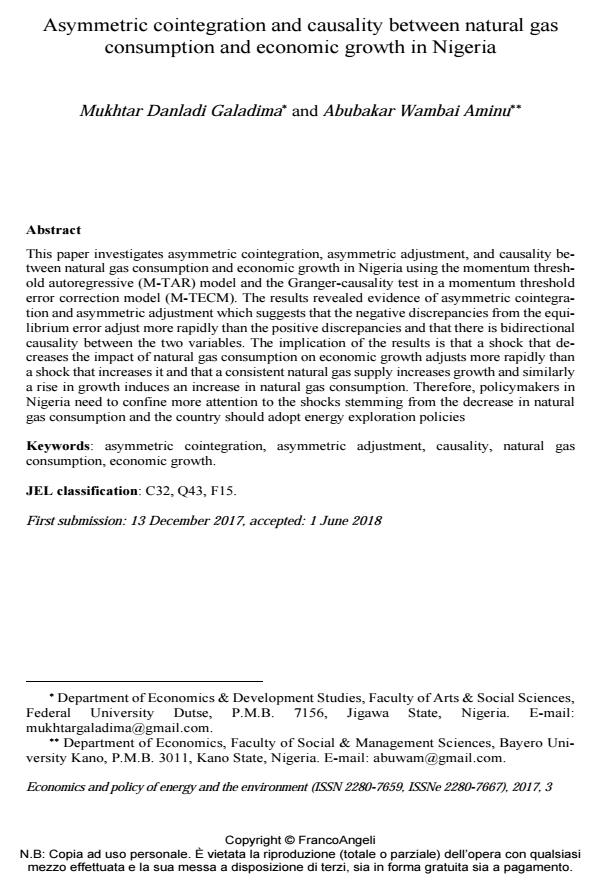Asymmetric cointegration and causality between natural gas consumption and economic growth in Nigeria
Journal title ECONOMICS AND POLICY OF ENERGY AND THE ENVIRONMENT
Author/s Mukhtar Danladi Galadima, Abubakar Wambai Aminu
Publishing Year 2018 Issue 2017/3
Language Italian Pages 13 P. 59-71 File size 240 KB
DOI 10.3280/EFE2017-003004
DOI is like a bar code for intellectual property: to have more infomation
click here
Below, you can see the article first page
If you want to buy this article in PDF format, you can do it, following the instructions to buy download credits

FrancoAngeli is member of Publishers International Linking Association, Inc (PILA), a not-for-profit association which run the CrossRef service enabling links to and from online scholarly content.
This paper investigates asymmetric cointegration, asymmetric adjustment, and causality between natural gas consumption and economic growth in Nigeria using the momentum threshold autoregressive (M-TAR) model and the Granger-causality test in a momentum threshold error correction model (M-TECM). The results revealed evidence of asymmetric cointegration and asymmetric adjustment which suggests that the negative discrepancies from the equilibrium error adjust more rapidly than the positive discrepancies and that there is bidirectional causality between the two variables. The implication of the results is that a shock that decreases the impact of natural gas consumption on economic growth adjusts more rapidly than a shock that increases it and that a consistent natural gas supply increases growth and similarly a rise in growth induces an increase in natural gas consumption. Therefore, policymakers in Nigeria need to confine more attention to the shocks stemming from the decrease in natural gas consumption and the country should adopt energy exploration policies
Keywords: Asymmetric cointegration, asymmetric adjustment, causality, natural gas consumption, economic growth.
Jel codes: C32, Q43, F15
- Short-term dynamics and long-term relationship between natural gas consumption and economic growth in Nigeria: an ARDL approach with breaks Mukhtar Danladi Galadima, Abubakar Wambai Aminu, Ibrahim Muhammad Adam, Ibrahim Mohammed Adamu, Hassan Hassan Suleiman, in Environmental Science and Pollution Research /2022 pp.52818
DOI: 10.1007/s11356-022-19457-8
Mukhtar Danladi Galadima, Abubakar Wambai Aminu, Asymmetric cointegration and causality between natural gas consumption and economic growth in Nigeria in "ECONOMICS AND POLICY OF ENERGY AND THE ENVIRONMENT" 3/2017, pp 59-71, DOI: 10.3280/EFE2017-003004